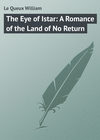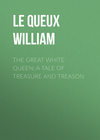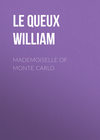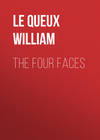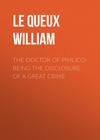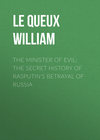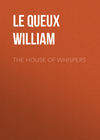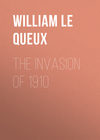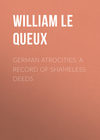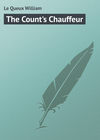Kitabı oku: «The Eye of Istar: A Romance of the Land of No Return», sayfa 17
Chapter Thirty Three
Where Dwelt the Devourer
In the appalling darkness that overwhelmed me, I fought, blindly beating the water with frantic hands. As I struggled to extricate myself from the power of the whirling current my arms suddenly struck against stones on either side. With desperate effort I put out my hands, and to my amazement found myself being carried onward, by a rushing flood, through what appeared to be a narrow tunnel in the face of the rock, deep below the lake’s surface. Though but half-conscious, I remember distinctly reflecting that the whirlpool had no doubt been caused by this violent outrush of water descending to feed some subterranean river, and that the chasm had probably been caused by the volcanic disturbance that had first attracted my attention. Half suffocated, and powerless against the roaring torrent, I was sucked downward, deep into the fathomless chasm.
Suddenly my fingers came in contact with a projecting ledge of rock, which I gripped with all my might, just managing to steady myself, and so arrest my further progress. Drawing breath, I was amazed to find that my head was above water, although the wild roar of the flood was deafening, and in the total darkness I could distinguish nothing. With set teeth I strained every muscle, and after several futile attempts, at length succeeded in scrambling over black, slime-covered stones beyond reach of the roaring torrent rushing down to mysterious subterranean depths. Strangely enough, the air seemed fresher than outside in the lake, for here, in the heart of the rock, there appeared to be ventilation. This discovery renewed my hopes. The aperture that admitted air would prove a means of egress from that dark, loathsome place, if only I could discover it. Though still giddy from the effects of the whirling waters, I rose slowly to my feet, and found that I could stand upright. With eager fingers outstretched before me I felt my way carefully onward over the rocks, rendered slippery by the sulphurous deposits of ages. In fear and trepidation lest I should slip and fall into some yawning fissure, I nevertheless groped on up a steady incline until suddenly my eyes caught a faint but welcome glimmer of grey light.
Towards this I stumbled on, falling once upon my hands and severely grazing them, but taking no heed of the accident in my breathless eagerness to discover some means of escape. I stood facing the mute darkness, all mystery, and gloom.
Clambering on over some rough boulders, and passing between the great rocks that had fallen so near to one another that it was with difficulty I squeezed between them, I at length found myself in an enormous cavern, from the vaulted roof of which depended gigantic stalactites, while high up, and inaccessible, was an aperture that admitted light and air, but, in front of me, all was a black, impenetrable darkness. The great place had, undoubtedly, been formed by the action of the water, but the process had involved an enormous length of time, and now the course of the subterranean stream had been diverted by some upheaval.
With the evil-smelling waters dripping from my ragged gandoura, I stood gazing around the great, natural chamber in wonderment. Was this the cavern described in the legends as the entrance to the Land of the No Return? the dwelling-place of the savage reptile that acted as janitor? My eyes were fixed upon the Cimmerian gloom beyond, for I feared to come face to face with some unknown and uncanny tenant of that chamber, where my timid footsteps echoed away into the impenetrable blackness, in which every sound became exaggerated, and every object weirdly distorted.
The sides of the cavern were apparently of rough, black granite, but in the grey light that fell across the place, the long crystals of fantastic shape glistened and shone with the brilliance of diamonds, and the floor, rough and uneven, was formed of huge boulders, that had evidently been tossed hither and thither by the violent volcanic eruption that had altered the angle of the strata outside. Little rivulets flowed over the floor, cutting deep channels in the stones, where blind and colourless crayfish of enormous size, and of unknown type, slowly crept, while, disporting themselves in the water, were strange, finny denizens of the subterranean river. On examination, I found they had no eyes, and had lost the colouration characteristic of their outer-world relatives, by reason of passing their whole time in total darkness. There were also great, grey toads, and fat, slowly-moving lizards, alike sightless and uncanny. From where I stood, the distant, roaring waters sounded like the continual, monotonous moaning of the storm-wind, and it was with failing heart that I proceeded with my explorations, for I well knew that to reach the exit high above was utterly impossible.
Without food or fresh water, I had been drawn into that great cavern by the whirlpool and entombed. Tiamo and Yakul, watching for me to rise to the surface, and finding that I had utterly disappeared, would, I knew, conclude that I had been drowned; and the dwarf, acting upon my instructions, would return to Kano, bearing the sad tidings to Azala. Alas! I could not communicate with them. In my helplessness I cried aloud unto Allah, the Most High, to show me the right path, but my wild wail only echoed through the hollow cavern, like the mocking voice of Azrael.
Under the great opening, that was overshadowed by a huge boulder, but into which blew fresh air in stormy gusts, showing that near the spot the rocks were open to the sky. I stood in full consciousness that could I but climb to that altitude I should be enabled to enter the forbidden land. Yet all thought of gaining that exit had to be abandoned. Even if I could scale the steep wall of the cavern, to reach the opening in its roof was impossible.
Here was yet another barrier between myself and the unknown.
Having carefully surveyed the cavern to right and left, I went forward at last, clambering over great, sharp stones that hurt my feet and grazed my elbows, and splashing into deep black pools, until, passing beyond the circle of light towards the portion of the strange place that remained in total darkness, my eager eyes suddenly caught sight of a portion of the black wall of the cave that had evidently been rendered flat and smooth by the hand of man, and upon it, deeply graven in the stone, but now half-obliterated by Time’s effacing finger, was a wall-picture, the extraordinary character of which held me amazed, petrified.
Over the strange, fantastic outlines my eyes travelled, deciphering the ancient scene it was intended to represent. An exclamation of amazement involuntarily escaped my parched lips, for it furnished me with the first clue to the mystery I was striving to elucidate. It told me of things of which I had never before dreamed.
Truly, I had struggled through the natural, and hitherto impassable barrier between the known world and that unknown, and was now actually on the threshold of a land of a thousand wonders.
The earnest, appealing words Azala had uttered, when requesting me to seek the truth, recurred to me, and, as I gazed upon these outlines, limned upon the rock-tablet by hands that ages ago had fallen to dust, I felt myself on the verge of a discovery even more extraordinary than any my wildest thoughts had ever framed.
The detail of the mysterious picture was amazing. Its art was unique – the art of a cultured, luxurious civilisation which had long been forgotten, even in the age when our lord Mahomet lived – but in it was one feature so curious and remarkable that its sight held me breathless, agape, transfixed.
The tablet, fashioned from the solid rock, was of great extent, with life-sized figures in bas-relief, sculptured with consummate skill, and as soon as my eyes caught sight of it I recognised its great antiquarian value. The study of forgotten nations had always attracted me from boyhood. Indeed, I had followed the example set by my father, who was perhaps the best-known antiquarian among the Arabs of Algeria, and was frequently sought out by travellers interested in the relics of bygone ages. While I was still a lad, he, at that time living in Constantine, met an Englishman named Layard, who came to examine the inscriptions at the Bab-el-Djabia and the ruins at Sidi Mecid, and subsequently embraced the opportunity of accompanying him through Kurdistan and Mesopotamia as interpreter. Afterwards, he assisted in the excavations on the sites of ancient Babylon and Nineveh, where many wonderful archaeological treasures were brought to light. He was present when the great winged bull was discovered beneath the mound of Nimroud, and on account of the keen interest he took in the various sculptures unearthed, and his ability to sketch them, he was promoted to be one of the Englishman’s chief assistants. Thus, from the first great discovery of Assyrian remains, my father had been enabled to study them, and when he returned home four years later, he brought with him many copies of strange cuneiform inscriptions, and drawings of curious sculptures, all of which interested me intensely. From him I thus derived my knowledge of the inscriptions of Babylonia, imperfect though it might be, but yet of sufficient extent to enable me to discern the Arabic equivalents of the strange lines of arrowheads graven upon this rock, and forming part of the picture I had so unexpectedly discovered. While at college in Algiers, I had eagerly devoured the few books in French, explaining the monuments of Babylonia, and in London had continued the study, by that means adding to the knowledge I had already gained under the tuition of my father. Few sons of Al-Islâm are archaeologists, but, as with my father, so also with me, the study had been a hobby, and on many occasions the French professors had expressed surprise at the extent of my knowledge of that strange language known as cuneiform.
By the dress and physiognomy of the figures portrayed upon the rock-tablet, I at once discerned they were not ancient Egyptian, as I at first believed, but Assyrian. The general arrangement of the picture showed it to be a record of similar character to those found in the wonderful buried palaces of Nineveh and Babylon.
In the faint glimmer of light I stood straining my eyes upon this silent record of a forgotten age. The first object I distinguished was a winged circle at the right-hand corner; the emblem of the Babylonian supreme deity. Below, in a chariot drawn by three handsomely-caparisoned horses, were three warriors in coats of mail, one being in the act of discharging an arrow at the enemy, one driving, and the third shielding his companions. The trappings of the horses, and the decorations of the chariot itself consisted of stars and other sacred devices, while at the side was suspended a quiver full of arrows, and the helmets of the warriors showed them to belong to the early Babylonian period. Following the chariot was a eunuch on foot, with a bow over his shoulder, a quiver slung behind, and bearing in his hand a kind of mace.
He was represented attired in a dress ornamented richly with gold and heavy fringe, while his upper garment was apparently a golden breastplate, across which showed the band by which the quiver was suspended. He wore no head-dress, and his feet were bare, but his position and bearing denoted that he was the servant of a monarch. Behind him there was depicted a chariot, not so gorgeously decorated as the first, drawn by two horses and led by two men, probably eunuchs. Over the horses’ heads rose high plumes, three in number, tassels fell over their foreheads and hung around their necks, together with rosettes, engraved beads and the sacred star; their tails were bound in the centre by ribbons, and suspended from the axle of the chariot was a large tassel. Standing behind, as if already passed by the expedition, the sacred tree was elaborately and tastefully portrayed, the tree bearing a large number of those mystic flowers that are so prominent a feature in early Babylonian decoration, showing that the dwellers within that wonderful city were possessed of highly-refined taste. Below was a picture of two scribes, writing down the number of heads and the amount of spoil, while the tablet behind them was occupied by many lines of graven arrowheads.
Underneath was pictured, in graphic detail, a peaceful, religious procession of gods, borne on the shoulders of warriors. Each figure was carried by four men: the first was that of a female seated on a throne, holding in one hand a ring, in the other a kind of fan, and on the top of her square, horned cap was a star. The next figure was also that of a female, wearing a similar cap, seated in a chair, and holding in her left hand a ring; she was also carrying something in her right hand, but its form I could not distinguish. The third figure puzzled me considerably; it was much smaller in its proportions than those preceding it, was half-concealed in a case or box, and had a ring in the left hand; while the fourth was that of a man in the act of walking, holding in one hand a thunderbolt, and the other an axe, evidently the Babylonian deity, Belus or Baal. Upon the identity of the other gods I was undecided, but in the right-hand corner of the tablet was sculptured a figure of the goddess Istar, the Assyrian Venus, draped and standing erect on a lion, crowned with a mural coronet, upon which was a star, denoting her divinity. In one hand she was represented as bearing the moon, and the other grasped two objects which had first attracted my attention and riveted my gaze. She was holding out two serpents, entwined in such a manner as to form the puzzling device with which my breast was branded – the Mark of the Asps!
Taking a small, flat stone, I stood on tiptoe and carefully scraped away the dirt of ages from that portion of the sculpture, finding underneath the two serpents engraven in minute detail. Then I scraped the dress of the eunuch and found the same symbol there depicted. Save in one or two instances, the ages that had passed since the great rock-tablet had been hewn had left it untouched. The deeper portions of the picture were, however, filled with dark grey moss and the accumulated dirt of centuries, but with the aid of the stone I commenced to scrape the inscriptions and very soon succeeded in so far cleaning them that the lines were decipherable.
It was apparent that the intention of the sculptor had been to portray, at the base of the picture, the procession of gods being carried into the Temple of Istar, or Astarte, but the reason she bore in her hand the entwined serpents was a mystery inscrutable. Upon the walls of the palaces at Nimroud, many representations of the goddess, bearing in her hand a single serpent, had been discovered, but never before had she been found pictured with the mystic symbol that had been the problem of my life.
I stood before the dark face of rock, speechless in wonderment, for here, as Azala had predicted, I had actually made a discovery, amazing and bewildering. The mark that we both bore upon our breasts had for ages remained engraven there, a symbol of forgotten deity, a device, no doubt, held in reverence and awe by a civilisation now vanished.
That vast, weird cavern, filled with the monotonous roar of tumbling waters, inhabited by blind, unknown animals and reptiles, yet rendered almost fairylike by its wonderful stalactites, which glittered whenever a shaft of pale light caught them, was indeed peopled by ghosts of the past. By whose hand had those marvellous pictures been chiselled? By whose order had that tablet been prepared? The dark, gloomy place was, indeed, well named the Gate of the Land of the No Return. Was I not actually within the Rock of the Great Sin? What, I wondered, was the nature of the great sin to which the rock had remained a mute witness?
With arms folded, I stood gazing upon the sculptured stone, long and earnestly, thinking, with affection, of the graceful, trustful woman who loved me, and for whose sake I had struggled to set foot upon ground that for ages had remained untrodden by man. Even at that moment I knew, alas! that her slave, Tiamo, would be on his way back to Kano to impart the news of my death, and I myself was powerless. To return was impossible. I was compelled to proceed.
But if I failed to discover any exit? The dread thought chilled my heart. Perhaps, after all, I had been entombed, and my fate would be death from starvation.
With only an impenetrable darkness beyond, the outlook was by no means reassuring; nevertheless, I struggled desperately to stifle my apprehensions, determined to decipher, as far as my knowledge served me, the cuneiform inscription, which I anticipated might explain the mystery of the symbol borne by the goddess Istar, whose worship formed such a historical feature in the religion of Babylon.
As I gazed around the dull, dispiriting, natural chamber, there crept over my heart a terrible sense of loneliness, such as I have never before experienced. Seized by an appalling, indescribable dread, I shuddered.
Next second, however, I set my teeth firmly, arguing within myself that upon my coolness my escape might depend, and then commenced a careful study of the parallel lines of chiselled characters. For fully an hour I was engaged in scraping and deciphering each word, finding their study so fascinating, that I actually forgot that I was alone in that wonderful natural prison. A considerable time elapsed before I could discover the commencement of the inscription, but having done so, I found that, with the exception of one or two small places, where the action of time upon the stone had caused it to fall in scales and thus efface the words, I could decipher it sufficiently well to ascertain its purport.
The words I read caused me to stand aghast. The statement, quaintly expressed and sometimes vague, staggered belief. Commencing about the centre of the tablet, it read as follows: —
“Ruler of the World and Builder of Babylon, the City of Cities, I, Semiramis, daughter of the Moon-god, Sin, who conquered the hosts of my enemies, who is never triumphed over by my foes, who put my captives to the sword and offered sacrifices, caused this record to be written by Nebu-sum-Iskum, my scribe, in the month Elul, day 18th, year 25th. Semiramis, Queen of Babylon.
“The record of my warriors, the battle-shout of my fighting, the submission of enemies hostile, whom Anu and Rimmon to destruction have given, on this my tablet and my foundation-stone have I written. The tablets of my father duly I cleaned; victims I sacrificed; to their places I restored for future days, for a day long hereafter, for whatsoever queen hereafter reigneth. When the temple of Anu and Rimmon, the gods great, my lords, its walls grow old and palaces decay, their ruins may she renew, my tablets and my foundation-stones duly may she cleanse, victims may she slay, to their places may she restore, and her name with mine may she write. Like myself, may Anu and Rimmon, the great gods, in soundness of heart and conquest in battle bountifully keep her. He who my inscriptions and my foundation-stones shall conceal, shall hide, to the water shall lay, to the fire shall burn, in dust shall cower in a home underground, a place, not seen for interpretation shall set, the name written shall erase and his own name shall write, and an attack evil shall devise; he also, from the world I have left, who seeketh to enter this my kingdom called Ea, the Land of the Lord of Wisdom, may Anu and Assur, the gods great, my lords, strongly injure him, and with a curse grievous may they curse him. May he wither beneath the touch of Niffer, lord of the Ghost Land, his kingdom may the gods dissipate, and may he be rooted up and destroyed from out of his country; the armies of his lordship may they devour, his weapons may they break, the destruction of his army may they cause; in the presence of his enemies wholly may they cause him to dwell; may the Air-god with pestilence and destruction his land cut off; want of crops famine and corpses against his land may he lay; against the sovereignty of his full power may he speak; his name, his seed in the land may he destroy.
“To extend my empire I left Ninyas, my son, to govern Babylon, and went forth with my legions into the land of the Ethiopians, and there overthrew mine enemies, of captives taken forty thousand, and of oxen twenty thousand, and much spoils of gold and silver and precious stones. And the number of the slaughtered men amounted to thirty thousand. Even while my warriors were counting their great spoils came there unto them news astounding, that over Babylon my son, Ninyas, had proclaimed himself king, whereupon my army that I had led rose up against me, their quern, and marched northward, through the land of the Egyptians, to the banks of the riverwhere I built Babylon and constructed my gardens that overhang and are unsurpassed. May they enter the regions of corruption, the dwelling of the deity Irkalla: may dust be their food, their victuals mud; may the light they not see, and in a terrible darkness dwell. Of my legions and my slaves as many as have remained loyal unto me, numbering twenty thousand, renounced their citizenship, and after wandering and fighting for twenty moons, accompanied me unto this place, the road whose way is without return, to the house whose entrance is without exit, there to found a country that I have named Ea, and raised up my throne in a city which standeth from this Rock of Sin, the Moon-god, fifteen marches towards the sunrise… Here have I offered sacrifices to the Sun-god and to Anu, and set up this my record. To this, my land, none may enter and none may leave on pain of a death terrible and swift. Upon him who breaketh this my commandment may the wrath of the Air-god most avenging fall, may he be smitten with pestilence, may his limbs rot and drop asunder, and may he fall captive in the hands of the great Devourer of the Living… Lo! I am Astarte, worshipped by men in the temples of Babylon, and the star is set upon my head. This my commandment have I written here, at the Gate of the Land of the No Return, which is the only entrance to the country without exit; the country in which I have raised the city called Ea, the gates of which are of brass, and the magnificence of which surpasseth even Babylon which I built, and upon which my curse hath now fallen. These are the words of Semiramis, the queen whom men call Istar, daughter of the Moon-god, the conqueror of all enemies, who founded the Kingdom of Ea, to which men from the world we have left may not enter, neither may a single man, woman or child among my subjects leave. Verily, this my kingdom is the Land of the No Return, and I, Semiramis, who ruled over Babylon, and who, as Istar, ruleth all men throughout the world, have here built my palace and established my foundation-stones and set up my monuments. This throne have I, the goddess-queen of the world and of the heavens, erected. He who seeketh to enter my forbidden kingdom, to tear it out or overthrow it, so shall he and his family be torn out and be overthrown, and from his place shall he be uprooted. And I have set up this throne in the strength of the Sun-god Shamas, lord of light, and driver away of evil, to whom I have offered sacrifices and burnt-offerings abundant. These words I speak.”
Thrice I deciphered this strange record from beginning to end, to reassure myself that my eyes did not deceive me, until at length I became convinced that I had elucidated its meaning correctly; that I was actually on the threshold of the Land of the No Return; that could I only escape from my subterranean prison, I might actually discover the hidden, unknown and mysterious Kingdom of Ea, founded by the great queen, who, ages ago, built the most wonderful city of cities.
I stretched forth my hands above my head, and with a loud voice implored the aid, protection and guidance of the One. But my words only came back to me from the dark, damp recesses of the cavern, deep, distinct and dismal. There was no exit.
